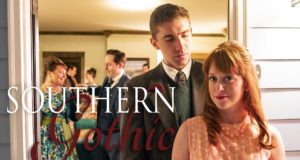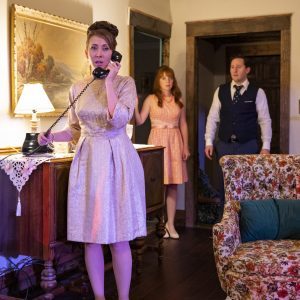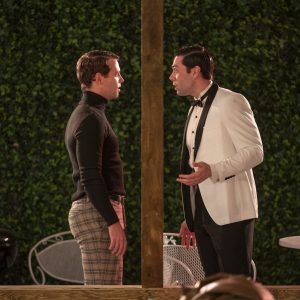
 [rating=3]“Southern Gothic” by Leslie Liataud is an immersive play currently at the Windy City Playhouse at their downtown Chicago location in the basement of Petterino’s Restaurant. A joint production with the Goodman Theatre and Greg Schaffert, this soap opera-type show is amazing in how well it depicts a close-knit group of upper class white people in Ashford, Georgia, a small-town where everybody knows each other, went to the same college, and basically is in each other’s business. A good script and fine acting make this presentation easy to watch, although be forewarned that it contains depictions of domestic violence and racism.
[rating=3]“Southern Gothic” by Leslie Liataud is an immersive play currently at the Windy City Playhouse at their downtown Chicago location in the basement of Petterino’s Restaurant. A joint production with the Goodman Theatre and Greg Schaffert, this soap opera-type show is amazing in how well it depicts a close-knit group of upper class white people in Ashford, Georgia, a small-town where everybody knows each other, went to the same college, and basically is in each other’s business. A good script and fine acting make this presentation easy to watch, although be forewarned that it contains depictions of domestic violence and racism.
Before the show starts, the audience members (i.e., the guests) receive an invitation for a celebration of Mrs. Suzanne Wellington (Anne Sheridan Smith), hosted by Ellie Coutier (Sarah Grant) and her husband Beau (Max Stewart). It’s supposed to be a house party for Suzanne’s 40th birthday, but the guest of honor is very upset about it: She doesn’t want to think of herself as being past 39 years old—and we see her take the banner down, while her husband Jackson (Joe Metcalfe) humors her. At the same time, Suzanne’s best friend Lauren Lyon (Curley Cornelius) takes the opportunity to insult her publicly (because she knows her so well). Charles, Lauren’s husband (Mat Bowdren) is seeking to become Georgia’s next U.S. senator, following in his father-in-law’s footsteps. Their associate Tucker Alsworth (Miles Borchard) brings Cassie Smith (Reese Parish), a black woman, to the house party—at a time when breaching the color line was not acceptable in polite white society. Cassie is currently an assistant to the local gossip columnist and aspires to become something greater in the field of journalism There is a well-noted expression, “Oh what a tangled web we weave.” This could easily apply to Ellie, who, as it turns out, has a history with several men. Combine this with everyone drinking too much and being a bit too frank, then you have the makings of an interesting fiasco. As for the details about the numerous and sundry characters and controversies, you’ll have to see the show for yourself.
The action is centered around a small house, elegantly recreated on stage. There is a living room, dining room, kitchen, patio, side porch, a short hallway, and even a bathroom, plus the exterior and its windows. (Note that the bedrooms and closets are closed off.) Scenic design by Scott Davis and the props design by Eleanor Kahn are authentic and super-highly detailed. The wood in the door frames, the lovely wooden furniture, the authentic couches and rugs from that era, the Tiffany-inspired ceiling fixture: all of these touches are marvelous, and add to the realism of the play. The costumes by Sydney Moore that date from 1961 are perfect for the era and appropriate for a fancy gathering. Not only are the actors splendidly dressed but nicely coifed too. It is fantastic to see how well they interact not just with each other but with the various props, so that the audience is made to feel that we are really onsite at a Southern family’s house. Sound designer Lindsay Jones has done a decent job with the audio, and dialect coach Linda Gates has gotten the cast to speak in well-honed Georgia accents.
The problem with the show, however, has to do with its logistics. I understand wanting the performance to appear realistic by having concurrent scenes in various rooms, but there are far too many centers of action. One group of characters may be talking in one room while another group is talking in another room, and possibly a third set is having a conversation elsewhere, and the audience doesn’t know where to place our collective attention. Inside our invitation, we are told in advance: “There is no way to hear everything, and that’s okay.” Most of the time, an important dialogue is said loudly enough in one room, so everybody hears it throughout the entire space. But almost as often, there are conflicting scenarios and discussions, such that we are not sure which bits of dialogue we should be focusing on and which bits are throwaway lines.
Because play’s focus frequently shifts from one room to another, it is expected that the audience will move throughout the set constantly, as compared to sitting in the living room or dining room areas for the entire time. Thus, we are instructed in advance to “hug the perimeter of each room”, leaving the center of the floor for the actors. But every so often, a character decides to place an item along the side of a room where we are standing (e.g., bar glasses on an occasional table), so, of course, we have to move to get out of their way. In my case, there was one occasion when the stage manager (wearing a headset) asked me to move away from an exterior window when the action was planned to spill from inside of the house to the outside. We are also asked to keep the doorways clear. But you never know exactly which doorway will be in use at a given moment, so that particular instruction conflicts with the fact that the audience is encouraged to mill around and experience the play from the standpoint of being in different rooms. When you have to be in perpetual motion to improve your sightlines or to follow a character or two, you need to watch out for the actors as well as your fellow audience members as everybody is roaming around the set just as you are.
What is most difficult about this show is that we often fear that we are missing something crucial to the plot if we fail to move to another area of the house at just the right moment. For example, neither my guest nor I (standing in totally different locations) got to see how the fight among the men got started on the patio. Considering that this was part of the climax, we apparently missed it. When I realized that something was happening that I couldn’t observe, I moved from the dining room to the patio and witnessed the tail end of the fight. But that wasn’t sufficient to understanding who fought whom and why.
So the question becomes how this particular show ought to be staged. For starters, an audience of forty-five people is too many for this set to hold comfortably. But having a smaller audience doesn’t solve the problem of poor sightlines. Building a larger and wider set would make it even more difficult to hear when something is going on in an adjacent room, and this would make audience members have to traverse a much greater distance to follow the action. The limitations of the set design consequently made me wonder whether this show ought to be immersive in the first place. I’m not sure the live audience added anything to the performance, except that we could have an alcoholic (or non-alcoholic) beverage when the cast did. I would quickly exchange this circumstance for having the audience being able to clearly see and hear everything that is being said and done by the characters.
To my mind, my guest came up with the best solution as to how to remedy the staging. Her suggestion is to have a very slowly rotating stage, so that the audience could witness all of the action from a 360-degree perspective from the comfort of our fixed seats. The set need only consist of a living room, dining room, and kitchen. The scenes which are set in other areas of the home could easily be subsumed into one of these three rooms. Of course, the venue would have to be a lot different, and the directing would not be the same.
Just remember that while “Southern Gothic” is very good, the constant need to follow the characters by milling about the house gets tedious over the course of 100 minutes (with no intermission), and soon it becomes an effort. Since you may not want to reclaim a seat that you have previously relinquished, be prepared to stand for much of the time.*
“Southern Gothic”, directed by David H. Bell and co-created by Carl Menninger and Amy Rubenstein, is running through November 30, 2022, at the Windy City Playhouse at Petterino’s Restaurant, 150 N. Dearborn Avenue, entrance on Randolph Street, northwest corner of Dearborn and Randolph, in Chicago.
General admission tickets are $80 – $105, depending on time and date of performance.
 Performance schedule:
Performance schedule:
Wednesdays and Fridays – 7:00 p.m.
Thursdays and Saturdays – 3:00 p.m. and 7:00 p.m.
Sundays – 1:00 p.m. and 5:00 p.m.
to reserve ( only 45 guests per performance) visit www.windycityplayhouse.com/southern-gothic/
COVID protocol: Proof of vaccination card is required on entry, subject to change at any time.
*Considering that you may be walking a lot throughout the performance, be careful to watch your step. This includes areas by the patio and side porch and the ramp near the front door of the house.
To see what others are saying, visit www.theatreinchicago.com, go to Review Round-Up and click at “Southern Gothic”. Make sure the 2022 version at Petterino’s.






More Stories
“The Last Five Years” MILWAUKEE
“The Trial of Themistocles” reviewed by Julia W. Rath
“Titanique”